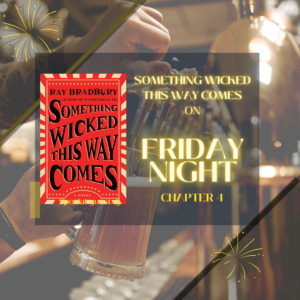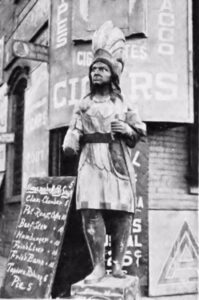For this post, I’ll be quoting from the following edition of Ray Bradbury’s masterful novel Something Wicked This Way Comes:
Bradbury, Ray. Something Wicked This Way Comes. Large Print edition, Center Point Publishing, 2000.
The page numbers will be different if you are reading from another edition of the book.
The first 3 chapters of Something Wicked This Way Comes focus on a few characters and a few places–the library and the houses where Jim Nightshade and Will Halloway live. The first 3 chapters are quiet, intimate, and controlled. During Chapter 4, however, the setting expands, we meet new characters, and the plot begins to thicken.
Chapter 4 begins on a Friday night, and read how Ray Bradbury brilliantly changes the story’s pace.

“Will stopped. Will looked at the Friday night town.
“It seemed when the first stroke of nine banged from the big courthouse clock all the lights were on and business humming in the shops. But by the time the last stroke of nine shook everyone’s fillings in his teeth, the barbers had yanked off the sheets, powdered the customers, trotted them forth; the druggist’s fount had stopped fizzing like a nest of snakes, the insect neons everywhere had ceased buzzing, and the vast glittering acreage of the dime store with its ten billion metal, glass and paper oddments waiting to be fished over, suddenly blacked out. Shades slithered, doors boomed, keys rattled their bones in locks, people fled with hordes of torn newspaper mice nibbling their heels. Bang! they were gone!” Bradbury page 30.

“They stomp-pound-thundered over iron grates, steel trap-doors, past a dozen unlit shops, a dozen half-lit, a dozen dying dark. The city was dead as they rounded the United Cigar Store corner to see a wooden Cherokee glide in darkness, by himself.” Bradbury page 30.

[Ray Bradbury was a boy during the 1950s when wood-carved Native Americans were used as advertisements outside cigar stores. The statues were massive–larger than life. Most people called these statues ‘wooden Indians.’ Advertising with these statutes is no longer a practice. In fact, these statues offend some people now. I’m not going to weigh in on this argument. Many people find Mark Twain’s writing disrespectful and racist for similar reasons. In my opinion, it is helpful if you can view older literature as the voice of the period in which the writing was produced. Fortunately, views on racism have changed since Mark Twain and Ray Bradbury wrote. In my opinion, we can’t fault old books that were written before the country became more racially aware.]
In chapter 4 of Something Wicked This Way Comes, we are introduced to the owner of the cigar store–Mr. Tetley and to Mr. Crosetti the barber. Mr.Crosetti also has a wooden Indian statue, but Will is mesmerized by the barber pole that continuously whirls in a never-ending, cyclical fashion. The light from the pole reflected upon a teardrop that was falling down Crosetti’s cheek
“Mr Crosetti took a trembling breath, snuffing. ‘Don’t you smell it?’ Jim and Will sniffed.
‘Licorice!’
‘Heck, no. Cotton candy!’
‘I haven’t smelled that in years,’ said Mr Crosetti.
Mr. Crosetti commented on this smell in the air: “‘And I’m crying. Why? Because I remember how a long time ago, boys ate that stuff. Why haven’t I stopped to think and smell the last thirty years?’”
Ray Bradbury is making an observation that is typical of the Romantic period of literature. The Romanticists believed that adults lose their abilities to feel about things as they age.
Chapter 4 of Something Wicked this way Comes is when hints of the coming circus first appear.
This is what Will said about the twisting barber pole, “…‘Where does it come from, where does it go, eh? Who knows? Not you, not him, not me. Oh, the mysteries….”
This is a reference to the cyclical nature of life–to the circle game.